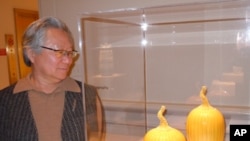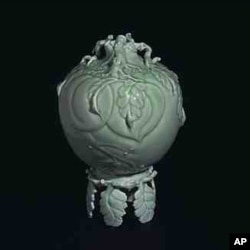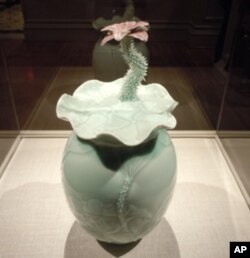Cliff Lee came to the United States from Taiwan in 1968. He spent the early days of his career as a neurosurgeon but gave it up five years later after discovering the joys of clay.
For the past 30 years, the former doctor has immersed himself in ceramics, using his surgical skills to create magnificent porcelain objects which he has exhibited in craft shows and galleries across the United States.
Now Lee has made it into the prestigious Renwick Gallery of the Smithsonian American Art Museum - a huge step up for an artist.
From surgery to ceramics
Lee loves to work with his hands. As a young doctor he used them to perform delicate brain surgery. Then, a patient introduced him to ceramics.
"As soon as I touched clay," says Lee, "time went by so fast, like meditation. So after that I started making pottery in my basement, every day after work."
Lee left medicine to devote himself fulltime to his new-found passion. For the past 30 years, the hands that once cut into bone have been shaping and carving objects in clay.
While Lee sees parallels between being a surgeon and a ceramic artist, he says there are differences.
"The clay doesn’t talk to me, and there’s no liability in case I make a mistake. I can redo it over and over again. I just feel this total freedom," he says.
Asian inspiration
Lee was raised in Taiwan where he was surrounded by Chinese ceramics, both at home and during frequent visits to museums.
Lee says his parents were collectors of ceramics, and took the family on frequent trips to museums, including the National Palace Museum in Taipei. "Subconsciously, unconsciously, I was educated, visually. I never realized that until later days."
Over the last three decades, Lee has blended his Asian heritage with his technical training to create flawless porcelain objects.
The award-winning artist draws inspiration from his surroundings.
"I live in a very beautiful section of Pennsylvania. Nature inspires me a lot. Every day, I’m searching for inspiration - the water, the lotus, my Koi ponds. I consider myself very, very lucky."
Big break
For years, Lee marketed his work mostly in craft shows, traveling around the country to display and sell them.
His big break came when a piece of his work was included in the White House Collection of Contemporary Crafts. Now, Lee is one of four artists whose work was chosen for a show at the Renwick Gallery of the Smithsonian American Art Museum in Washington.
Nicholas Bell, the museum's curator, says every two years the Renwick Gallery mounts what’s called the Renwick Craft Invitational.
"It’s where we look at trends that are emerging in American craft and look for some of the artists that we think are the best to illustrate them, and people that are deserving of broader national attention," he says.
Imperial Yellow Glaze
The Renwick is also impressed with the amount of research Lee has done for his art. For example, Lee spent years investigating how Chinese glazes were made centuries ago. And then set out to recreate them, using his knowledge of chemistry to find just the right ingredients.
"Probably his best known glaze is the Imperial yellow glaze which was originally discovered in the 15th century and was so rare and hard to create," says Bell. "The yellow was such a pure color that it was reserved for use by the Imperial court during the Ming dynasty."
Lee spent 17 years re-creating that glaze from scratch.
"Failure after failure after failure until one day he opened the kiln door and it came out perfectly," says Bell.
Lee remembers that time, and says his wife and kids thought he was "possessed."
"They never saw me. The only time they saw me, was mealtimes."
Forty pieces of Lee’s work are on display at the museum, including his signature Yellow Imperial pottery.
Lee says being at the Renwick is the highlight of his career.
"Thirty years ago, I came to the Renwick Gallery. I said ‘I’d like to have my exhibit here someday.’ And over the years I worked, worked, worked. And I’m very, very fortunate being selected by the panel."
And he is also, deeply grateful.
"I think people in the United States, or people studying ceramic, or children, they should realize that we live in a wonderful, wonderful country. If you set your mind to it, you can do anything you want. And the sky is the limit, because I learned all this in the United States. I got all my resources in the United States. I owe so much to this country."











